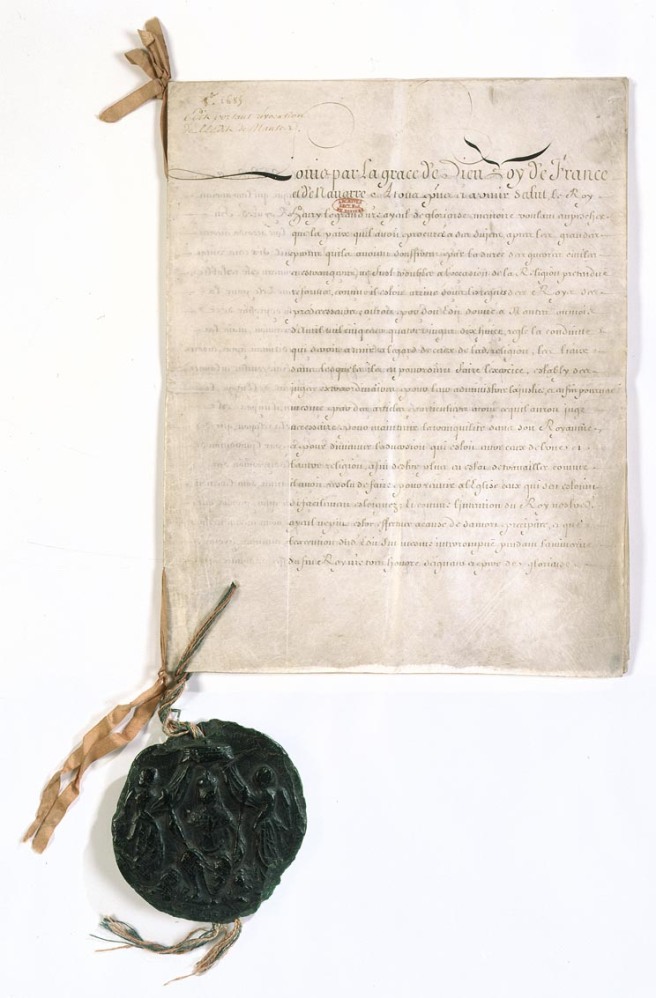
“And not to leave any occasion of trouble and difference among our Subjects, we have permitted and do permit to those of the Reformed Religion, to live and dwell in all the Cities and places of this our Kingdom and Countreys under our obedience, without being inquired after, vexed, molested, or compelled to do any thing in Religion, contrary to their Conscience, nor by reason of the same be searched after in houses or places where they live, they comporting themselves in other things as is contained in this our present Edict or Statute.”
Article 6 of the Edict of Nantes codifies the peace between Protestants and Catholics in France after the Wars of Religion, which were a series of civil wars occurring from 1562 and lasting until the issuance of this Edict in 1598. Henry IV, a former Protestant himself, reinstated many measures which promoted pacification of both Protestants and Catholics with this Edict. These measures included a number of precursors to modern law: the right to exercise religion, freedom from harassment, protections against unwarranted seizure of property or persons, and similar articles which did not favor either religious group, but accorded to each some measure of autonomy in practice.
Click here for more excerpts from the Edict of Nantes.

The Edict of Fontainebleau, also known as the Revocation of the Edict of Nantes, was issued by Louis XIV in order to eliminate the practice of the Protestant faith in France. It prohibited the exercise of the Protestant faith, “in any place or private house, under any pretext whatever excuse it can be.” Among other articles, it also forbade nobles from joining or practicing the Protestant faith, forced the expulsion of those who were unwilling to convert to Catholicism from France and dictated that all children born to Protestants were to be baptized as Catholics. Somewhere between 200,000 and 250,000 Huguenots left France in the late 17th century. While they mainly settled in Protestant European countries such as the Dutch Republic, Britain and Germany, some settled in South Africa and a few hundred left for the American Colonies.
Click here for a link to the full text of the Edict of Fontainebleau.
As you can see, we have wildly differing leadership between Henry IV and Louis XIV, who was Henry’s grandson. The Revocation was one of the main reasons that Huguenots left France. It’s likely that Jean de Jarnat was among these refugees.
On a somewhat related note, is anyone else watching Versailles? I know the first series/season is done in the UK, but we just started it here in the States. I’m interested to see how it stacks up to the historical realities of King Louis XIV’s court. So far, it seems interesting, even if it is drawing from the more sensational elements of the time period.
Sources
- Henry IV. “Edict of Nantes.” Edict of Nantes. Accessed September 27, 2016. http://www2.stetson.edu/~psteeves/classes/edictnantes.html.
- Henry IV. “Edit De Nantes Avril 1598.” Digital image. Wikimedia Commons. June 6, 2009. Accessed September 27, 2016. https://commons.wikimedia.org/wiki/File:Edit_de_Nantes_Avril_1598.jpg.
- Louis XIV. “Edict of Fontainebleau (October 22, 1685).” Internet Modern History Sourcebook. July 1998. Accessed October 2, 2016. http://huguenotsweb.free.fr/english/edict_1685.htm.
- Louis XIV. “The Edict of Fontainebleau, Revocation of the Edict of Nantes, 1685.” Digital image. Wikimedia Commons. August 13, 2010. Accessed October 2, 2016. https://commons.wikimedia.org/wiki/File:Revocation_of_the_Edict_of_Nantes.jpg.
- Murdoch, T. V. “Dispersion.” In The Quiet Conquest: The Huguenots 1685-1985, 51. London: Museum of London, 1985.
